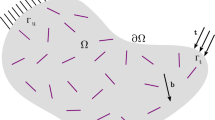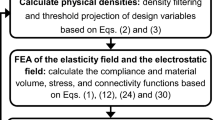Abstract
The design of manufacturable variable-stiffness (VS) composite with stiffness and strength requirements is still challenging work. This paper presents an optimization method to achieve such a design, in which the Tsai–Wu strength failure criteria and manufacturing requirements are simultaneously integrated into the compliance minimization problem. A novel parameterization scheme based on the compactly supported radial basis functions is proposed to make the design variable bounded so as to conveniently solve the optimization problem by the gradient-based solver. Owing to the proposed parameterized scheme, the fiber continuity is inherently ensured. Other manufacturing requirements are related to its curl and divergence operations and are easily simplified as the point-wise constraint forms. Further, global strategies based on the p-norm aggregation approach are adopted to handle thousands of local strength constraints and manufacturing constraints. The designs of minimizing the compliance without or with manufacturing constraints, and maximizing strength without or with manufacturing constraints are also conducted and compared. Meanwhile, the effects of the number of the support points, support radius, initial design are also investigated. Numerical results indicate that the effectiveness of the proposed optimization method for designing curvilinear VS composite structures considering the strength, stiffness, and manufacturability.


























Similar content being viewed by others
References
Albazzan MA, Harik R, Tatting BF, Gürdal Z (2019) Efficient design optimization of nonconventional laminated composites using lamination parameters: a state of the art. Compos Struct 209:362–374
Brooks TR, Martins JRRA (2018) On manufacturing constraints for tow-steered composite design optimization. Compos Struct 204:548–559
Catapano A, Montemurro M (2020) Strength optimisation of variable angle-tow composites through a laminate-level failure criterion. J Optim Theory Appl 187:683–706
Chen Y, Ye L (2021) Topological design for 3D-printing of carbon fibre reinforced composite structural parts. Compos Sci Technol 204:108644
Cheng H, Kikuchi N, Ma Z (1994) An improved approach for determining the optimal orientation of orthotropic material. Struct Multidisc Optim 8(2):101–112
Chu S, **ao M, Gao L, Zhang Y, Zhang J (2021) Robust topology optimization for fiber-reinforced composite structures under loading uncertainty. Comput Methods Appl Mech Eng 384:113935
Demir E, Yousefi-Louyeh P, Yildiz M (2019) Design of variable stiffness composite structures using lamination parameters with fiber steering constraint. Compos Part B 165:733–746
Ding H, Xu B (2021a) Optimal design of laminated plate for minimizing frequency response based on discrete material model and mode reduction method mode reduction method. Eng Comput 1:014281
Ding H, Xu B (2021b) Optimal design of vibrating composite plate considering discrete-continuous parameterization model and resonant peak constraint. Int J Mech Mater Des 17:679–705
Ding H, Xu B (2021c) A novel discrete-continuous material orientation optimization model for stiffness-based concurrent design of fiber composite. Compos Struct 273:114288
Ding H, Xu B, Huang C, Duan Z (2021) A multi-scale discrete material optimization model for optimization of structural topology and material orientations to minimize dynamic compliance. Struct Multidisc Optim 64:1343–1365
Ding H, Xu B, Duan Z, Li W, Huang X (2022) A cascadic multilevel optimization framework for the concurrent design of the fiber-reinforced composite structure through the NURBS surface. Eng Comput 2022:1
Erdal O, Sonmez FO (2005) Optimum design of composite laminates for maximum buckling load capacity using simulated annealing. Compos Struct 71(1):45–52
Fernandez F, Compel WS, Lewicki JP, Tortorelli DA (2019) Optimal design of fiber reinforced composite structures and their direct ink write fabrication. Comput Methods Appl Mech Eng 353:277–307
Fiordilino GA, Izzi MI, Montemurro M (2021) A general isogeometric polar approach for the optimisation of variable stiffness composites: application to eigenvalue buckling problems. Mech Mater 153:103574
Fukunaga H, Sekine H (1992) Stiffness design method of symmetric laminates using lamination parameters. AIAA J 30:2791–2793
Gao J, Gao L, Luo Z, Li P (2019) Isogeometric topology optimization for continuum structures using density distribution function. Int J Numer Methods Eng 119:991–1017
Grenestedt J, Gudmundson P (1993) Layup optimization of composite material structures. Optimal design with advanced materials. Elsevier, Amsterdam, pp 311–336
Gürdal Z, Tatting B, Wu C (2008) Variable stiffness composite panels: effects of stiffness variation on the in-plane and buckling response. Compos Part A 39:911–922
Hao P, Liu C, Yuan X, Wang B, Li G, Zhu T, Niu F (2017) Buckling optimization of variable-stiffness composite panels based on flow field function. Compos Struct 181:240–255
Hao P, Yuan X, Liu C, Wang B, Liu H, Li G, Niu F (2018) An integrated framework of exact modeling, isogeometric analysis and optimization for variable-stiffness composite panels. Comput Methods Appl Mech Eng 339:205–238
Hao P, Liu D, Wang Y, Liu X, Wang B, Li G, Feng S (2019) Design of manufacturable fiber path for variable-stiffness panels based on lamination parameters. Compos Struct 219:158–169
Henrichsen SR, Lindgaard E, Lund E (2015) Robust buckling optimization of laminated composite structures using discrete material optimization considering “worst” shape imperfections. Thin-Walled Struct 94:624–635
Holmberg E, Torstenfelt B, Klarbring A (2013) Stress constrained topology optimization. Struct Multidisc Optim 48:33–47
Huang G, Wang H, Li G (2016) An efficient reanalysis assisted optimization for variable-stiffness composite design by using path functions. Compos Struct 153:409–420
IJsselmuiden ST, Abdalla MM, Gürdal Z (2010) Optimization of variable-stiffness panels for maximum buckling load using lamination parameters. AIAA J 48(1):134
Izzi MI, Montemurro M, Catapano A, Pailhès J (2020) A multi-scale two-level optimisation strategy integrating a global/local modelling approach for composite structures. Compos Struct 237:111908
**g Z, Sun Q, Silberschmidt VV (2016) Sequential permutation table method for optimization of stacking sequence in composite laminates. Compos Struct 141:240–252
Julien ZG, van Campen MJF, Kassapoglou C (2011) Design of fiber-steered variable- stiffness laminates based on a given lamination parameters distribution. In: Structural dynamics and materials conference. pp 1–11.
Kennedy GJ (2016) A full-space barrier method for stress-constrained discrete material design optimization. Struct Multidisc Optim 54:619–639
Khani A, Ijsselmuiden ST, Abdalla MM, Gürdal Z (2011) Design of variable stiffness panels for maximum strength using lamination parameters. Compos Part B 42:546–552
Koh R, Madsen B (2018) Strength failure criteria analysis for a flax fibre reinforced composite. Mech Mater 124:26–32
Lund E (2018) Discrete Material and Thickness Optimization of laminated composite structures including failure criteria. Struct Multidisc Optim 57:2357–2375
Luo J, Gea H (1998) Optimal orientation of orthotropic materials using an energy-based method. Struct Multidisc Optim 15(3):230–236
Luo Y, Chen W, Liu S, Li Q, Ma Y (2020) A discrete-continuous parameterization (DCP) for concurrent optimization of structural topologies and continuous material orientations. Compos Struct 236:111900
Matsuzaki R, Mitsui K, Hirano Y, Todoroki A, Suzuki Y (2021) Optimization of curvilinear fiber orientation of composite plates and its experimental validation. Compos Struct 255:112956
Tian Y, Pu S, Shi T, **a Q (2021) A parametric divergence-free vector field method for the optimization of composite structures with curvilinear fibers. Comput Methods Appl Mech Eng 373:113574
Miki M, Sugiyama Y (1993) Optimum design of laminated composite plates using lamination parameters. AIAA J 31:921–922
Montemurro M, Catapano A (2017) On the effective integration of manufacturability constraints within the multi-scale methodology for designing variable angle-tow laminates. Compos Struct 161:145–159
Montemurro M, Catapano A (2019) A general B-spline surfaces theoretical framework for optimisation of variable angle-tow laminates. Compos Struct 209:561–578
Montemurro M, Pagani A, Fiordilino GA, Pailhès J, Carrera E (2018) A general multi- scale two-level optimisation strategy for designing composite stiffened panels. Compos Struct 201:968–979
Nikbakt S, Kamarian S, Shakeri M (2018) A review on optimization of composite structures part I: laminated composites. Compos Struct 195:158–185
Niu XJ, Yang T, Du Y, Xue ZQ (2016) Tensile properties of variable stiffness composite laminates with circular holes based on potential flow functions. Arch Appl Mech 86:1551–1563
Niu B, Shan Y, Lund E (2019) Discrete material optimization of vibrating composite plate and attached piezoelectric fiber composite patch. Struct Multidisc Optim 60:1759–1782
Papapetrou VS, Patel C, Tamijani AY (2020) Stiffness-based optimization framework for the topology and fiber paths of continuous fiber composites. Compos Part B 183:107681
Pedersen P (1991) On thickness and orientational design with orthotropic materials. Struct Multidisc Optim 3(2):69–78
Peeters DMJ, Hesse S, Abdalla MM (2015) Stacking sequence optimisation of variable stiffness laminates with manufacturing constraints. Compos Struct 125:596–604
Shimoda M, Muramatsu Y, Tsukihara R (2020) Minimization of maximum failure criterion of laminated composite shell structure by optimizing distributed-material orientation. Struct Multidisc Optim 61:1547–1571
Sjølund JH, Peeters D, Lund E (2019) Discrete material and thickness optimization of sandwich structures. Compos Struct 217:75–88
Stegmann J, Lund E (2005) Discrete material optimization of general composite shell structures. Int J Numer Methods Eng 62(14):2009–2027
Svanberg K (2002) A class of globally convergent optimization methods based on conservative convex separable approximations. SIAM J Optim 12:555–573
Tian Y, Pu S, Zong Z, Shi T, **a Q (2019) Optimization of variable stiffness laminates with gap-overlap and curvature constraints. Compos Struct 230:111494
Van De WN, Hurley J, Khanbolouki P, Sarvestani AN, Tamijani AY, Tehrani M (2019) Design considerations and modeling of fiber reinforced 3D printed parts. Compos Part B 160:684–692
Wei P, Li Z, Li X, Wang MY (2018) An 88-line MATLAB code for the parameterized level set method based topology optimization using radial basis functions. Struct Multidisc Optim 58:831
Wu Z, Raju G, Weaver PM (2015) Framework for the buckling optimization of variable- angle tow composite plates. AIAA J 53:3788–3804
**a Q, Shi T (2017) Optimization of composite structures with continuous spatial variation of fiber angle through Shepard interpolation. Compos Struct 182:273–282
Xu YJ, Zhu JH, Wu Z, Cao Y, Zhao Y, Zhang W (2018) A review on the design of laminated composite structures: constant and variable stiffness design and topology optimization. Adv Compos Hybrid Mater 1:460–477
Xu Y, Gao Y, Wu C, Fang J, Sun G, Steven GP, Li Q (2021) On design of carbon fiber reinforced plastic (CFRP) laminated structure with different failure criteria. Int J Mech Sci 196:106251
Yan X, Xu Q, Hua H, Huang W, Huang X (2020) Concurrent optimization of macrostructures and material microstructures and orientations for maximizing natural frequency. Eng Struct 209:109997
Zhou XY, Ruan X, Gosling PD (2019) Thermal buckling optimization of variable angle tow fibre composite plates with gap/overlap free design. Compos Struct 223:110932
Funding
This work was supported by the National Natural Science Foundation of China (11872311) and the Natural Science Basic Research Plan in Shaanxi Province of China (2020JM085).
Author information
Authors and Affiliations
Contributions
Author **aodong Huang have contributed as co-corresponding author to this work. His mail ID: xhuang@swin.edu.au.
Corresponding author
Ethics declarations
Conflict of interest
The authors declare that they have no conflict of interest.
Replication of results
We are confident that the paper contains sufficient detail on methodology and implementation. In case of questions or difficulties, readers are welcome to contact the authors.
Additional information
Responsible Editor: **feng Wang.
Publisher's Note
Springer Nature remains neutral with regard to jurisdictional claims in published maps and institutional affiliations.
Rights and permissions
Springer Nature or its licensor holds exclusive rights to this article under a publishing agreement with the author(s) or other rightsholder(s); author self-archiving of the accepted manuscript version of this article is solely governed by the terms of such publishing agreement and applicable law.
About this article
Cite this article
Ding, H., Xu, B., Li, W. et al. Design of curvilinear variable-stiffness composites considering stiffness, strength and manufacturability. Struct Multidisc Optim 65, 244 (2022). https://doi.org/10.1007/s00158-022-03306-w
Received:
Revised:
Accepted:
Published:
DOI: https://doi.org/10.1007/s00158-022-03306-w




